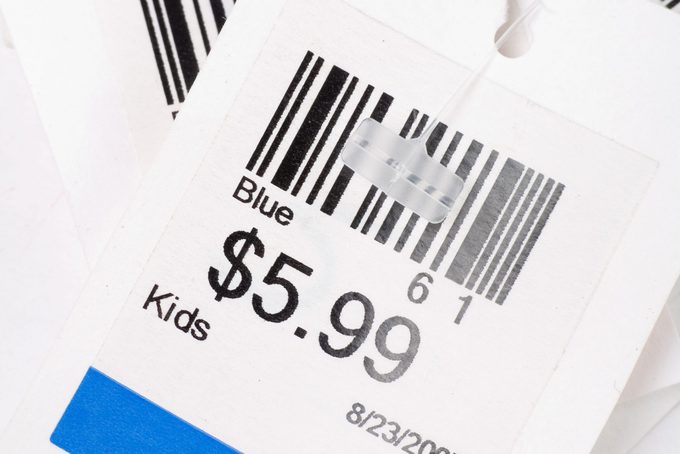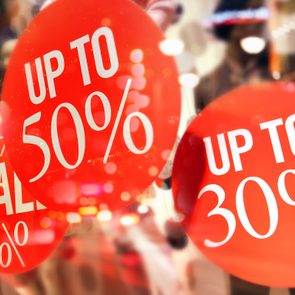There's a method to the madness—and it’s backed by psychology. Here's why prices often end in 99 cents.

The Real Reason Most Prices End in .99

If you’ve ever asked yourself, “Why do prices end in 99?” you’re not alone. Whether it’s a grocery store or a car commercial, many of the prices you encounter have this in common: Prices are more likely to end in .99 than any other pair of numbers—and certainly more than the even .00. We probably don’t think twice about buying something for $5.99 or $16.99, but it is a little strange, when you think about it.
So why aren’t prices just even dollar amounts? Is it an elaborate marketing scheme to get you to spend more? Read on to learn why it seems like just about every price ends in 99.
Get Reader’s Digest’s Read Up newsletter for more humor, cleaning, travel, tech and fun facts all week long.
Why do prices end in 99?
Yes, it is all about marketing. But there’s really nothing “elaborate” about it. “It’s a type of psychological pricing,” says Julie Ramhold, a consumer analyst with DealNews.com. “Because we read from left to right, we pay less attention to the end of the number versus the beginning.” This is especially effective if you’re quickly perusing several prices in a row—the first number, on the left, will definitely stand out to you more. That’s the same mental shortcut retailers rely on when using psychology-based strategies to nudge shoppers into spending more, often without the shoppers realizing it.
How do our brains see prices?
Of course, we still know that $9.99 is basically $10, not $9. But the .99 trick takes advantage of the way our brains process prices. When we see a price of $9.99, we associate it as part of the $9–$9.99 range rather than the $10–$10.99 range. “Consumers don’t want to transcend a certain category, so even a penny less may make a huge psychological difference,” explains Subimal Chatterjee, distinguished teaching professor of marketing at Binghamton University School of Management. This is especially effective when it’s a change in the number of digits—$99.99 is just inside the “two-digits” range, so it seems like you saved money, even though you are basically paying $100. And, of course, the retailers are getting the most money they possibly could within that lower range, because 99 cents is only a penny below the higher range.
What does research tell us about pricing?
Research backs this up. In a study published in the Journal of Consumer Research, researchers found that prices ending in .99 are perceived as significantly lower than prices just one cent higher, but only when the leftmost digits change. For example, $2.99 feels cheaper than $3.00, but $22.99 doesn’t have the same effect compared with $23.00 because the leftmost digit hasn’t changed. This psychological reaction, known as the left-digit effect, becomes even stronger when consumers are comparing two similar products side by side. And interestingly, the phenomenon doesn’t just apply to prices—it shows up with other multi-digit numbers too.
Why do we ignore prices that are rounded up?
Basically, in a prices/sales setting, we just subconsciously forget all the basics of rounding we learned in second grade. Instead of rounding up everything that ends with .5 and above, we tend to round prices down based on their first digit. As Mary Potter Kenyon, author of Coupon Crazy, explains, “We see $9.99 and think of it as priced for $9 and some cents, instead of rounding it up to $10. We look at a price tag of $10 and we see it as $10, rather than one penny more than the $9.99 price tag!”
Are prices ever even on purpose?
Of course, there are some prices that do end in even dollar amounts, but it is usually a deliberate choice. You might see even-dollar prices at thrift stores or secondhand shops, where the prices aren’t pre-determined or are marked down. Ramhold explains that you’ll also see this on clearance items: “Often it’s when they’ve gone as low as they can, so a clearance item at the store might be just $3.”
On the other end of the spectrum, because .99 comes across as cheaper, some high-end retailers choose to avoid this. They will price things evenly to make it seem like the items are particularly good quality, in a practice called “prestige pricing.”
Does .99 pricing work online?
Some experts argue that charm pricing may not be as effective online, where consumers are more analytical and likely to comparison shop. However, others say that in digital retail—where shoppers are still drawn to lower visual numbers while browsing—a .99 price tag continues to perform well.
How can you avoid falling into the .99 trap?
So, how can you avoid falling into the .99 trap? Be aware of the subtle tactics stores use to encourage spending. It probably goes without saying, but make sure you read the full price tag of something before you buy it—and make sure you’re correctly rounding that price to the nearest dollar amount, not to the first digit.
About the experts
|
Why trust us
At Reader’s Digest, we’re committed to producing high-quality content by writers with expertise and experience in their field in consultation with relevant, qualified experts. We rely on reputable primary sources, including government and professional organizations and academic institutions as well as our writers’ personal experiences where appropriate. We verify all facts and data, back them with credible sourcing and revisit them over time to ensure they remain accurate and up to date. Read more about our team, our contributors and our editorial policies.
Sources:
- Julie Ramhold, consumer analyst with DealNews.com
- Subimal Chatterjee, distinguished teaching professor of marketing at Binghamton University
- Mary Potter Kenyon, author of Coupon Crazy and lecturer on savings strategies
- Journal of Consumer Research: “Penny Wise and Pound Foolish: The Left-Digit Effect in Price Cognition”
- Coupon Crazy: The Science, the Savings, and the Stories Behind America’s Extreme Obsession






















